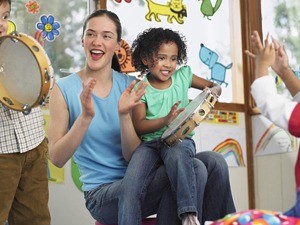- 855.224.8655
- Schedule a Tour

Music has strong effects on mood and learning, making it a great classroom tool when used correctly. From helping children learn new languages to creating a positive classroom environment, there are many ways that preschool teachers can use music to their advantage. These are just some ideas of how you can utilize music.
Signal classroom transitions.
If your class sometimes has trouble making the transition from one activity to another, playing music during these periods can be a good way to help them. Choose a certain song to represent each daily activity, then play it each day when it’s time for your students to shift their attention or focus.
Soon, the music will indicate to students that it’s time to pause and switch gears, while requiring minimal verbal instructions from you.
Use music strategically. Try to avoid keeping it on as background noise, otherwise, it could lose its purpose.
Manage the classroom’s energy.
If it’s nap time and your classroom has extra energy, a soothing lullaby can help them calm down and rest. Likewise, energetic songs with fast tempos like the Macarena and the Hokey Pokey will get your class ready for physical activity. Use music as a way to release energy and refocus.
Create multisensory learning experiences.
Music can enhance what your students are already learning. For example, you could use music, sound-making, and rhythm to aid in listening and reading comprehension. It’s a great way to keep children engaged with the lesson. And, it creates a multisensory experience.
At classroom storytime, try reading a book like We’re Going on a Bear Hunt. This book includes a lot of repetition, which makes it easy to follow along. Throughout the story, your classroom can perform the actions and sound effects that the book illustrates.
Teach new vocabulary and language.
Because song lyrics are often repetitive, it makes it easier for preschoolers to memorize and retain new vocabulary.
Find thematic, developmentally-appropriate songs to help children improve their vocabulary. Or research children’s songs in a foreign language to help them become confident using another language.
Here are a few other tips to keep in mind when using music in the classroom:
- Use instruments or classroom objects to make music; don’t just listen to music.
- Expose children to different types of music, instruments, and sounds. Music comes in many forms.
- If possible, have an area of the classroom where children can practice rhythm making or play music spontaneously.
- Most importantly, have fun!
Music is a fun way to enhance your students’ classroom experience. It’s also a tool that can help you be more effective as a teacher.
